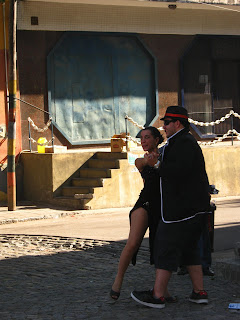부에노스아이레스에 있는 동안 사실 '관광'이란 걸 많이 하지는 않았다. 짧게 있는 게 아니다 보니 굳이 '오늘' 이곳 저곳을 돌아다니며 구경할 필요가 없었다. 물론 찌는 듯한 무더위 탓이기도 했다. 자기 전에는 '내일은 여기를 가볼까?'했지만 해가 중천에 떠버리고 나면 너무 더워서 의욕이 싹~ 사라졌었으니. 그래도 아르헨티나 다른 지역에서 만났던 친구들이 부에노스아이레스에 왔을 때 만큼은 나름대로의 관광을 하기는 했다.
While I was in Buenos Aires, I didn't do much of 'sightseeing'. As I was staying there for a while, there was no need of wandering around the city 'today'. In a sense, this was due to the scorching weather; it was just too hot to walk around during the day time. It was only when some friends whom I got to know in other parts of Argentina came to Buenos Aires that I more or less became a tourist and did a bit of sightseeing. For the rest of the time, I was just hanging around with people and most importantly, dancing tango.
원래 투어프로그램에 참여하는 건 별로 좋아하지 않지만, Alex의 추천을 받고 Buenos Aires free tour을 하게 되었다. free tour는 국회의사당에서 시작해 세계에서 가장 넓은 대로라는 Avenida 9 de julio(7월 9일 대로)를 지나 대통령이 직무를 보는 Casa Rosada를 거쳐 부에노스아이레스의 상징인 오벨리스크까지 도보로 이동하는 3시간 짜리 프로그램이다. 단순히 사실을 나열한다기 보다 부에노스아이레스와 관련된 숨겨진 비화들을 들려주는 방식이어서 꽤 재미있었다. 특히 짧은 시간동안 부에노스아이레스를 방문하는 사람이라면 참여할 만 하다. 단지 모든 것이 그러하듯 완전히 '공짜'인 것은 아니고 가이드에게 팁을 쥐어주는 것이 예의다.
I basically don't like participating in tours but since Alex, who hates tours more than I do, recommended 'Buenos Aires Free Tour', I ended up doing it this time. It is a 3-hour free walking tour program which starts from the congress, crosses 'Avenida 9 de julio', passes by Casa Rosada, where the president works and then finishes at Obelisk, the landmark of Buenos Aires. It was quite interesting since the guide told us some anecdotes or unknown stories. Particularly, if you are visiting Buenos Aires for a short time, it is worth doing this tour. Yet, it is not completely free but you just pay some tips to the guide.
 |
| on the right was the guide |
 |
the so-called widest avenue in the world: avenida 9 de julio,
in the center is obelisk |
 |
On that main avenue were demonstrations for Indians' rights;
Buenos Aires is the city of demonstrations |
 |
| obelisk at night |
 |
| around Plaza de mayo |
 |
on the other side of the plaza was situated 'Casa Rosada(Pink house)',
where the president works |
 |
| the most famous and the oldest cafe in Buenos Aires |
|
this is how it looks inside: very classic,
but it was just too touristy to feel a bit of Buenos Aires |
 |
| the congress |
 |
| there are old cars in every corner |
 |
Florida street, the shopping street of Buenos Aires,
where all the shops are situated |
 |
| the city of Tango |
Puerto Madero. 부에노스아이레스의 옛 항구였던 지역이나 지금은 부에노스아이레스에서 가장 현대적이면서도 비싼 곳이다. 서울마냥 고층 빌딩들이 솟아있고 강변을 따라 고급 레스토랑들이 즐비하며 사람들은 선선한 바람을 즐기며 여유롭게 산책한다. 번잡한 부에노스아이레스 중심부와는 너무 다른 모습.
Puerto Madero, once a port district, now is the most modern and expensive area in Buenos Aires. There are too many skyscrappers for Buenos Aires, upper-class restaurants along the river and people walking their dogs with breezes. It is totally different from 'busy' and 'crowded' Buenos Aires.
 |
the area's landmark: Women's bridge(Puente de la mujer)
by Spanish architect, Santiago Calatrava |
 |
| on the bridge |
 |
Crossing Puerto Madero, you will end up with 'Costanera Sur',
locals' retreat on weekends, full of inexpensive but delicious sandwich stalls |
 |
'el chapulin', my favorite sandwich place where I always had BONDIOLA,
Argentine-style sandwich with a grilled thick piece of beef, yummy! |
산텔모(San Telmo)는 여행자들이 주로 머무는 지역으로 매주 일요일마다 열리는 벼룩시장이 유명하다. Dorrego 광장에서부터 시작해서 Defensa 거리를 따라 8~10블록 정도 빽빽하게 가판이 들어서있다. 골동품, 헌책에서부터 악세서리나 옷가지에 이르기까지 온갖 물건들을 판다.
San Telmo is where most of travellers stay and is famous for its weekly flea market. On Sundays, the 'Defensa' street is filled with different stalls for about 10 blocks. They sell pretty much all stuffs: from antiques and old books to accessories and clothes.
 |
| stalls of antiques @Plaza Dorrego |
 |
| tango dancers |
 |
| plenty of mates(argentine-style tea cups) |
 |
| when the market is over, there are people playing 'Candombe' |
탱고가 태어났다는 라보카(La Boca)지역의 까미니또(El caminito). 100여년 전 이곳에서 하층 이민자들이 삶의 애환을 노래하고 춤추었던 것이 바로 탱고. 탱고의 발생지라는 수식어와 알록달록한 건물들 덕택에 부에노스아이레스관광에서 빼 놓을 수 없는 곳이지만 오로지 '관광'만을 위한 곳이라 모든 것이 인위적일 따름이었다.
El Caminito is a small street in 'La Boca' area where tango was born. It is said that over hundred years ago, lower class immigrants danced tango to comfort themselves. Thanks to the phrase 'where tango was born' and to its unique colorful buildings, it is a must see in Buenos Aires. However, as it was a place only for 'tourists', everything there seemed artificial.
 |
| With a bit of money, you can turn into a tango dancer as well. |
 |
As 'La Boca' is where Boca Juniors is from,
there are paintings of Maradona everywhere. |


























